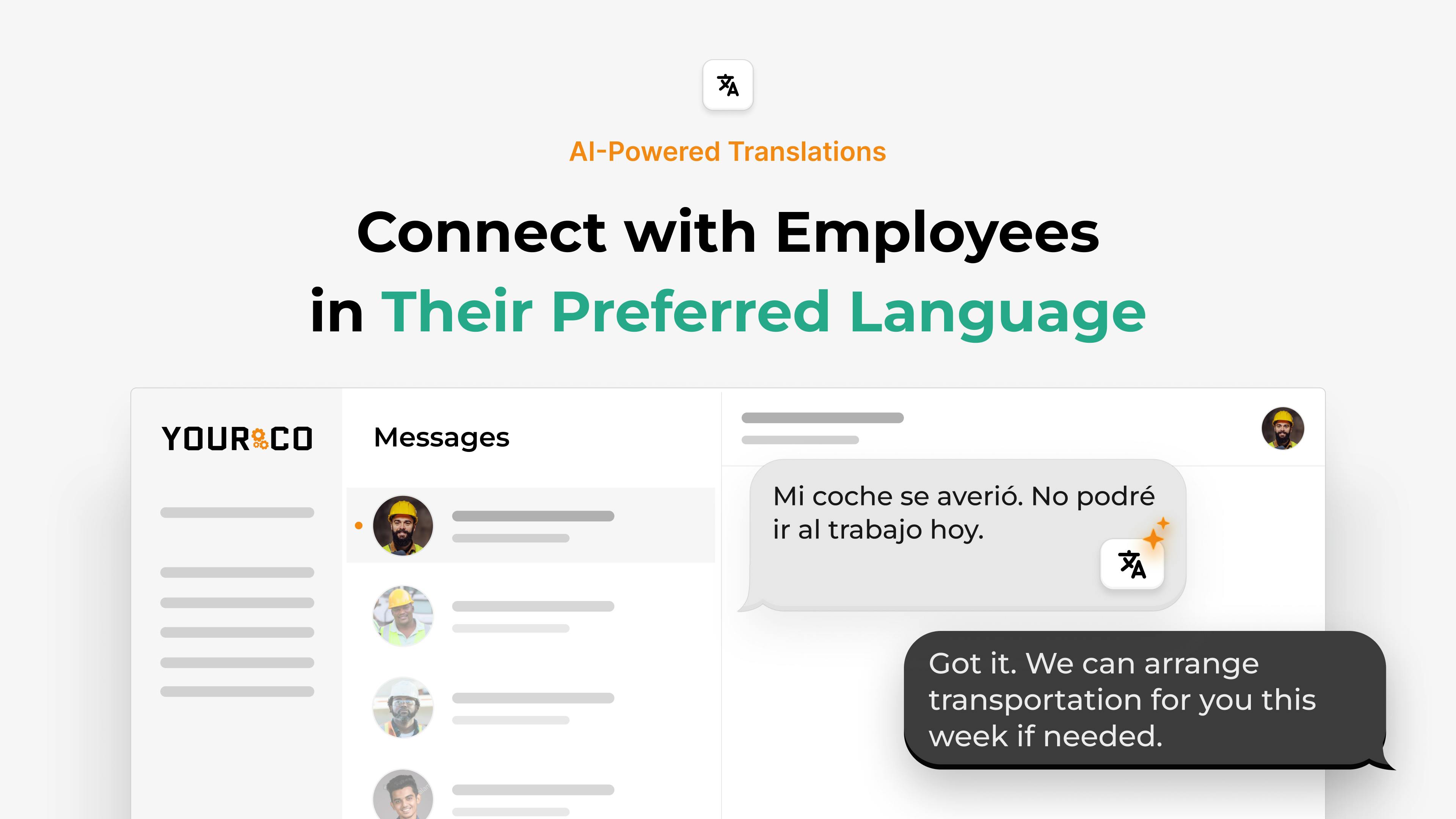How to Deliver Compliance Training for Chinese-Speaking Workers


When compliance messages don’t reach everyone clearly, even a small misunderstanding can lead to major safety or legal issues. This risk grows when your workforce includes Chinese-speaking employees who struggle with English training materials or word-for-word translations that miss cultural context. Technical terms like “lockout/tagout” or “whistleblower” often have no direct Chinese equivalent, which makes confusion more likely.
Delivering compliance training in clear, culturally adapted Chinese helps workers truly understand and apply what’s required. The result is fewer safety lapses, stronger participation, and compliance that lasts.
Recognize the Communication Barriers Chinese-Speaking Workers Face
Many safety lapses start with a simple misunderstanding, and Chinese-speaking crews face extra risks when instructions arrive only in English. You can't assume every employee grasps technical rules or legal jargon just because someone translated the slide deck.
Work Around Language Gaps and Dialect Differences
Language creates the biggest hurdle. Frontline staff in manufacturing, construction, and logistics often have limited English skills, making dense regulatory terms hard to follow even after translation. Some concepts like "whistleblower" or "lockout/tagout" have no direct Chinese equivalent, so meaning gets lost during word-for-word conversion. Dialect differences between Mandarin, Cantonese, and regional variants make this worse. A single message can land in several confusing versions.
To work around this, companies can simplify compliance terms, use visual aids, and send short, localized messages tailored to each dialect group.
Address Cultural Communication Patterns
Workplace culture adds another layer of difficulty. Traditional respect for hierarchy often stops workers from asking clarifying questions, and the focus on maintaining harmony can make people nod along even when they're confused.
Overcome Workplace Access Limitations
The work environment creates its own problems. Frontline workers handle rotating shifts, noisy machinery, and limited computer access, so they miss traditional training delivery methods. Literacy levels vary too. Some workers learn better through visuals or spoken Mandarin than through thick documents.
These communication gaps lead to consequences such as safety shortcuts, failed audits, and costly downtime.
Adapt Training Materials for Clarity and Cultural Fit
Creating compliance materials that work for Chinese-speaking workers means focusing on clarity first. Break down complex information into simple, direct language using short sentences and everyday vocabulary. Each instruction should focus on one clear action. When regulations like FCPA or SOX don't translate directly into Chinese, explain the concept in plain terms your team can understand and act on.
Cultural context matters just as much as accurate translation. Choose Simplified Chinese for mainland operations or Traditional Chinese for Taiwan and Hong Kong locations. Replace American examples with scenarios that reflect relationship-building practices, since guanxi influences many workplace decisions in Chinese business culture. Workers respond better when they understand why rules exist, not just what the rules are.
Testing your materials before company-wide rollout prevents confusion and builds trust:
- Have bilingual supervisors review both language and cultural tone to catch awkward phrasing or culturally insensitive examples.
- Run a pilot with a small group of workers to identify confusing sections and gather feedback on comprehension.
- Refine the content based on feedback before final deployment, addressing any gaps in understanding.
- Use universal icons, step-by-step diagrams, and photo-based instructions so someone can follow safety protocols at a glance.
Clear language combined with strong visuals transforms mandatory training into practical guidance your team can trust and follow.
Choose Communication Channels That Reach Every Worker
The way you send compliance updates matters as much as the message itself. When notices arrive late, or never get seen, Chinese-speaking crews miss deadlines, safety steps, and critical certifications.
Traditional channels fall short. Paper posters get buried under dust or replaced before every shift rotation, and physical bulletin boards work only if workers pass by them during breaks. SMS cuts through all of those barriers. A text carries a 98% open rate and lands instantly on any phone, even basic models without internet. Because texts arrive in seconds, you can reach Chinesee-speaking employees no matter the shift, location, or noise level around them.
Text messaging works perfectly for quick, actionable alerts:
- Send training schedules with site addresses and start times directly to workers' phones.
- Remind crews about certification deadlines with simple messages like "Forklift card expires Friday, reply 1 after you renew."
- Share direct links to translated safety manuals that workers can access immediately.
- Push real-time protocol changes during inspections or emergencies when every second counts.
Picture a busy foreman on a high-rise. He taps out one message in Simplified Chinese (明天上午 7 点在 3 号仓库进行叉车再认证) and every operator sees it before clock-in. No downloads, no passwords, just a short text that keeps your team compliant and your project moving.
Reinforce Learning Through Two-Way Engagement
Training only sticks when you know workers truly understand it, so every compliance message should invite a response, not just push information. Text messaging makes that easy since messages land where employees already pay attention. By turning each alert into a quick dialogue, you create ongoing engagement that keeps Chinese-speaking crews accountable.
Use short, focused prompts and let workers answer in their own language. Automatic translation tools can facilitate bilingual messaging, so you may see replies in English while they read and type in Chinese. This removes hesitation about vocabulary or grammar and surfaces misunderstandings before they become violations.
Simple comprehension checks work best:
- Poll for understanding by asking workers to choose 1 if goggles are required for today's task, or 2 if not.
- Send one-question quizzes like "What's the max forklift load? Choose A, B, or C."
- Ask for feedback with "Was yesterday's lockout demo clear? Reply Y or N."
- Confirm completion by having workers text DONE after they watch a three-minute safety video.
Two-way texting does more than teach. It creates accountability. Every response is timestamped, creating an auditable record that helps you show regulators the training reached each worker and that comprehension was checked. Managers also spot knowledge gaps instantly and can schedule follow-up in minutes, keeping the learning cycle continuous without pulling anyone off the floor.
Build Continuous Learning Into Daily Routines
Single training sessions don't stick. Workers forget key details within days, and that's when costly mistakes happen. Ongoing reinforcement keeps safety rules and compliance requirements fresh in everyone's minds.
Regular touchpoints work better than intensive one-time sessions, especially for Chinese-speaking teams who may need extra time to process complex regulations. A simple routine keeps crews engaged without disrupting daily operations:
- Send weekly safety tips or deadline reminders by text to keep compliance top-of-mind.
- Follow up with monthly microlearning modules that break down one regulation into a five-minute lesson.
- Schedule quarterly refreshers on your highest-risk topics to reinforce critical procedures.
- Deliver just-in-time updates right before workers start hazardous tasks.
You can adjust timing to match shifts and busy seasons. Rotate topics each week (fire safety today, equipment protocols next week) so messages stay relevant without feeling repetitive. Keep each message brief, include links to translated guides when needed, and ask for quick confirmation like "Reply 1 when you finish the safety video" to track understanding.
This steady flow of information transforms compliance from an annual event into part of your team's daily routine. Chinese-speaking workers get the reinforcement they need to stay safe and follow regulations, while you build a culture where doing things right becomes second nature.
Connect Every Worker with Instant SMS Updates
Language barriers, rotating shifts, and limited device access keep many Chinese-speaking crew members from seeing important compliance updates, putting safety and legal standing at risk. Yourco fixes that by meeting workers where they already pay attention: their text inbox.
Yourco delivers instant SMS alerts that land on any phone without requiring downloads or passwords. The platform's built-in AI translation covers over 135 languages and dialects, including both Simplified and Traditional Chinese, and flips replies back into English so nothing gets lost in communication. This two-way texting lets workers confirm training, ask questions, or report issues without leaving the factory floor.
Every interaction creates searchable message logs that give you an auditable trail for every training reminder and response. Simple integrations pull employee lists from your HR system, ensuring you always reach the right people across all shifts and locations. Managers can send targeted messages by department, location, or shift, so frontline crews only receive information relevant to their work.
Workers never pay for messages since our platform provides toll-free numbers, and managers send updates through a web dashboard without using personal phones. Start sending clear, translated updates today and keep every worker, on any shift, fully informed.
Try Yourco for free today or schedule a demo and see how the right communication tool can transform your workplace safety.
Frequently Asked Questions
What's the best approach for workers with varying levels of literacy?
Combine plain-language text with visuals (icons, step-by-step photos, and short videos). Hands-on demos during shifts also help employees who prefer learning by doing, a method shown to boost retention for food-safety crews.
How can I track who has completed required training?
Send every assignment through a system that logs delivery and captures replies. When a worker texts back "DONE," that confirmation, timestamp, and translated message stay in an auditable record you can export for regulators.
What's the optimal frequency for compliance reminders?
Focus on consistency over volume. Weekly micro-tips and monthly refreshers keep rules top-of-mind without overwhelming phones. Research on multilingual programs shows spaced repetition dramatically improves long-term recall compared with annual marathons.
How do I balance regulatory requirements with cultural sensitivity?
Anchor the core rule, then illustrate it with local scenarios. For example, explain anti-bribery laws alongside everyday "guanxi" situations so workers see how global policies apply in Chinese business culture.




